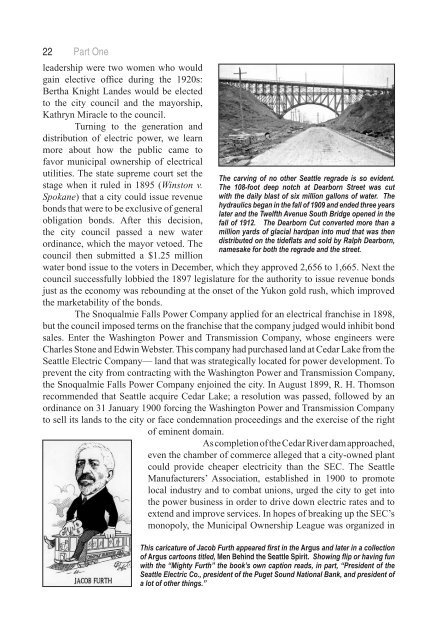Seattle: 1900-1920 -From Boomtown, Through Urban Turbulence ...
Seattle: 1900-1920 -From Boomtown, Through Urban Turbulence ...
Seattle: 1900-1920 -From Boomtown, Through Urban Turbulence ...
- No tags were found...
Create successful ePaper yourself
Turn your PDF publications into a flip-book with our unique Google optimized e-Paper software.
22 Part Oneleadership were two women who wouldgain elective office during the <strong>1920</strong>s:Bertha Knight Landes would be electedto the city council and the mayorship,Kathryn Miracle to the council.Turning to the generation anddistribution of electric power, we learnmore about how the public came tofavor municipal ownership of electricalutilities. The state supreme court set thestage when it ruled in 1895 (Winston v.Spokane) that a city could issue revenuebonds that were to be exclusive of generalobligation bonds. After this decision,the city council passed a new waterordinance, which the mayor vetoed. Thecouncil then submitted a $1.25 millionThe carving of no other <strong>Seattle</strong> regrade is so evident.The 108-foot deep notch at Dearborn Street was cutwith the daily blast of six million gallons of water. Thehydraulics began in the fall of 1909 and ended three yearslater and the Twelfth Avenue South Bridge opened in thefall of 1912. The Dearborn Cut converted more than amillion yards of glacial hardpan into mud that was thendistributed on the tideflats and sold by Ralph Dearborn,namesake for both the regrade and the street.water bond issue to the voters in December, which they approved 2,656 to 1,665. Next thecouncil successfully lobbied the 1897 legislature for the authority to issue revenue bondsjust as the economy was rebounding at the onset of the Yukon gold rush, which improvedthe marketability of the bonds.The Snoqualmie Falls Power Company applied for an electrical franchise in 1898,but the council imposed terms on the franchise that the company judged would inhibit bondsales. Enter the Washington Power and Transmission Company, whose engineers wereCharles Stone and Edwin Webster. This company had purchased land at Cedar Lake from the<strong>Seattle</strong> Electric Company— land that was strategically located for power development. Toprevent the city from contracting with the Washington Power and Transmission Company,the Snoqualmie Falls Power Company enjoined the city. In August 1899, R. H. Thomsonrecommended that <strong>Seattle</strong> acquire Cedar Lake; a resolution was passed, followed by anordinance on 31 January <strong>1900</strong> forcing the Washington Power and Transmission Companyto sell its lands to the city or face condemnation proceedings and the exercise of the rightof eminent domain.As completion of the Cedar River dam approached,even the chamber of commerce alleged that a city-owned plantcould provide cheaper electricity than the SEC. The <strong>Seattle</strong>Manufacturers’ Association, established in <strong>1900</strong> to promotelocal industry and to combat unions, urged the city to get intothe power business in order to drive down electric rates and toextend and improve services. In hopes of breaking up the SEC’smonopoly, the Municipal Ownership League was organized inThis caricature of Jacob Furth appeared first in the Argus and later in a collectionof Argus cartoons titled, Men Behind the <strong>Seattle</strong> Spirit. Showing flip or having funwith the “Mighty Furth” the book’s own caption reads, in part, “President of the<strong>Seattle</strong> Electric Co., president of the Puget Sound National Bank, and president ofa lot of other things.”


